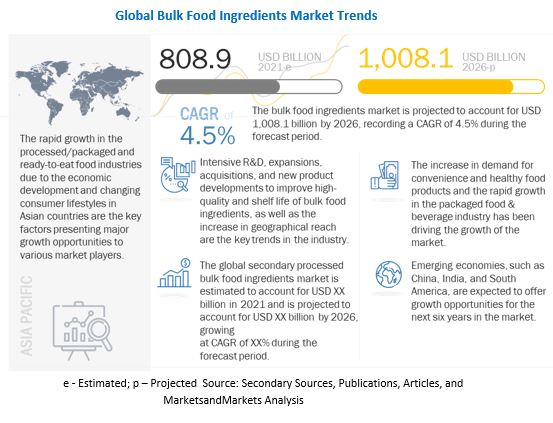
The global bulk food ingredients market size is estimated to be valued at USD 808.9 billion in 2021. It is projected to reach USD 1,008.1 billion by 2026, recording a CAGR of 4.5% during the forecast period. The change in perception of people pertaining to processed foods and the technological innovations in bulk food ingredient processing techniques have led to an increase in demand for processed products, and subsequently to the growth of the bulk food ingredients market.
Download PDF brochure: https://www.marketsandmarkets.com/pdfdownloadNew.asp?id=2141018
Some of the prominent key players are:
• Tate & Lyle PLC (UK)
• Cargill, Incorporated (US)
• Archer Daniels Midland Company (US)
• Olam International (Singapore)
• DuPont (US)
• Ingredion Incorporated (US)
The herbs & spices segment by product type is projected to achieve the fastest growth in the bulk food ingredients market.
The herbs & spices is the fastest-growing segment product type during the forecast period. Key factors such as the increase in consumer preference for healthy food products, production of bulk food ingredients, import of bulk food ingredients and ease of availability, demand for natural/clean label products, and preference for convenience food products due to busy lifestyles is projected to drive the demand for bulk food ingredients.
The food segment by application is projected to account for the largest market share of the bulk food ingredients market over the forecast period.
The food segment is projected to account for the largest share owing to to the growing middle-class population and urbanization, which has led to an increase in the disposable income of people. The increase in demand for snacks & convenience food products in the Asia Pacific region has witnessed a rise in demand for various bulk food ingredients that have led consumers to adopt healthier lifestyles.
Request Sample Pages: https://www.marketsandmarkets.com/requestsampleNew.asp?id=2141018
Geographic Prominence
The demand for bulk food ingredients is projected to increase in the Asia Pacific region due to key factors, such as the rise in disposable income and urbanization in countries such as China, India, and Japan. Furthermore, the rise in consumer awareness about the benefits of clean/natural label products in Asian countries is projected to offer growth opportunities to food & beverage manufacturers. However, high price volatility and unstable agricultural supply are the key factors that are projected to inhibit the market growth. In addition, improper infrastructural facilities, such as warehousing, act as a challenge for market players.
